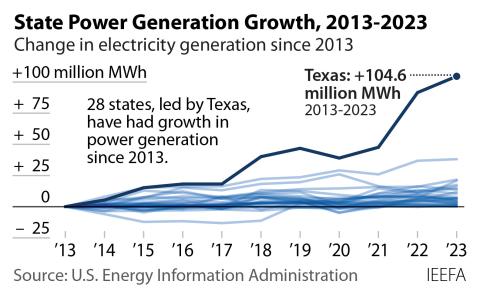Ohio: The Swing State for Presidential Elections, and National Energy Policy Too
Every four years, Ohioans brace for the presidential election. Ads flood the airwaves, yard signs sprout like daffodils, and it seems presidential candidates (of all stripes) appear at every Labor Day parade, community event, and pancake breakfast in the state (for a fun way to see what it’s like to live in Swing State Hell, watch this classic episode of the Daily Show from November 2012).
Ohio today is also the primary national battleground between the coal industry and the renewable-energy/energy-efficiency industries.
Through 2010, Ohio got over 80 percent of its electricity from coal, and the state had the largest number of coal-fired units in the country. Many of Ohio’s major coal plants until then had avoided compliance with the basic pollution controls required by the Clean Air Act of 1990, but a recent series of court cases, EPA rulings, and a growing pressure to protect public health forced the utilities to decide whether to spend hundreds of millions of dollars to upgrade old plants or shut them down. As a result, 10 of Ohio’s 20 major coal plants are closing.
Meanwhile, natural gas has become more available and more competitive with coal and—as it happens—utilities are having to comply with a law Ohio enacted in 2008 requiring utilities to meet minimum standards for energy efficiency and renewable energy. There’s also the fact that Ohio deregulated electricity in 1999, which has made it tougher for coal plants to compete in the electricity marketplace.
The effect of all these forces—changing fuel markets, more responsible and better-enforced public policy and the rise of natural gas—has been a significant loss of market share for coal. In 2013, about 69 percent of Ohio electricity came from coal, a 13-percentage point drop over 2010.
The coal industry, and its closest allies among utilities, hasn’t taken any of this lying down. Despite dramatic decreases both in coal electric generation and in coal-mining activity in Ohio (caused by the shift away from high-sulfur coal), the coal industry still has powerful influence in the halls of the Statehouse in Columbus, and it has wielded it.
Ohio is home to both Robert Murray of Murray Energy, perhaps the nation’s most vociferous defender of the coal industry, and FirstEnergy, the utility that covers most of the northern part of the state and has led the successful (and unconscionable) charge to freeze Ohio’s energy-efficiency and renewable standards, a move the Legislature approved last June. FirstEnergy is working against good public policy in other ways, too. In August, its executives asked the Public Utilities Commission of Ohio (PUCO) to re-regulate two of its most unprofitable plants, the W.H. Sammis coal plant and the Davis-Besse nuclear plant, moves that would protect both from market forces. Such a change would amount to a FirstEnergy bailout that would burden Ohioans with $3 billion in additional electric costs, according to an analysis just completed for the Ohio Office of Consumers Counsel and the Northeast Ohio Public Energy Council.
Yet all is hardly lost.
Key decisions will be made this year both on the re-regulation of coal plants and on a further freeze on efficiency and renewables expansion. If history were the only guide, the sure bet would be that Ohio will kowtow to the coal industry as it has traditionally done.
But that bet is off, and here’s why:
- Many of the state’s most powerful companies, represented by the Ohio Manufacturers Association, the Industrial Energy Users of Ohio, Walmart and others have come out clearly against the proposed FirstEnergy bailouts and many of them support maintaining energy-efficiency and renewables standards.
- The growth in jobs in the state from investments in wind and solar energy has been well documented. The Ohio Development Services Agency, for one, has put the total number of “alternative energy” jobs in the state at more than 30,000.
- Unlike many states, Ohio has a strong law allowing municipalities to aggregate their electric purchases and then band together to negotiate with utilities in a collective-bargaining style of strong public policy. The Northeast Ohio Public Energy Council (NOPEC), which represents 500,000 customers in 174 municipalities, is the largest such group in the country, and NOPEC opposes the bailout and holds considerable sway with FirstEnergy.
- Governor John Kasich, who is clearly the Decider in this situation, refused in 2014 to support FirstEnergy’s original plan for an outright rollback of the energy efficiency and renewables standards, resulting in the decision instead to “freeze” or pause the standards for a legislative review. The governor appoints and influences the members of PUCO and is the standard-bearer for the heavily Republican-dominated state Legislature. He has made a number of moves to build political support in Northeast Ohio, where constituents would be hit hardest by the $3 billion in overcharges. Kasich is rumored to be testing the waters for a presidential run himself, and may not want to position himself as an opponent of cleaner energy technologies or to set the anti-free-market precedent by abandoning Ohio’s deregulation laws.
Kasich also led the campaign to get the national Republican Party to hold its 2016 presidential convention in Cleveland, a coup for the city, which beat out Dallas, Denver and Las Vegas, among others.
So GOP delegates from all over the country will be in Cleveland in July 2016, where from their gathering place in the city’s sparkling new convention center they’ll be looking out toward a towering wind turbine that provides some of the power for the nearby Great Lakes Science Center. By then, we’ll know whether that turbine is a sign of Ohio’s new clean energy policy or just a relic of the past.
Sandy Buchanan is IEEFA’s executive director.











